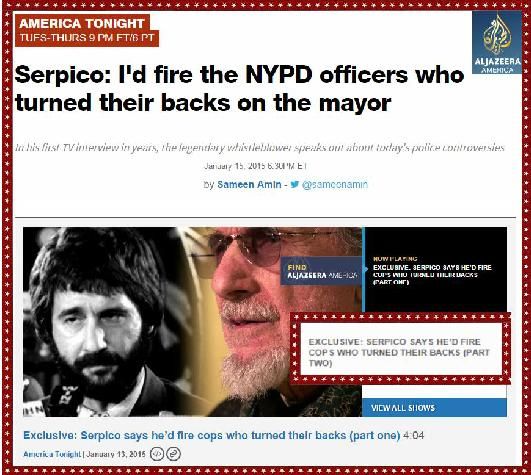Serpico (remember him?) Comes Out of Obscurity To Fight For Justice

READ MORE HERE: http://america.aljazeera.com/watch/shows/
america-tonight/articles/2015/1/15/serpico-i-d-
firethenypdofficerswhoturnedtheirbacksonthemayor.html
I watched the fascinating Frank Serpico interview on the "Aljazeera American Tonight" Channel on January 13, 2015 and witnessed Frank Serpico, who at age 78, still has some fight left in him. His story, made into a major motion picture, acknowledged him as the embodiment of bravery and a crusader for justice. Risking his life to bring light to the criminal activity within the ranks of the NYPD who were hired as communal protectors of the public not as tyrannical oppressors, of which they had become.
He is speaking out again, telling the world that some of the best and brightest within the NYPD (and elsewhere)
have habituated back to their old corrupt habits of 45 years ago.
have habituated back to their old corrupt habits of 45 years ago.
(To put it mildly.)
Read the Wikipedia outline (below) on this amazing man. And watch the embedded video, Part 1 and Part 2.
NYPDIn September 1959, Serpico joined the New York City Police Department (NYPD) as a probationary patrolman. He became a full patrolman on March 5, 1960. He was assigned to the 81st precinct, then worked for the Bureau of Criminal Identification (BCI) for two years. He was finally assigned to work plainclothes, where he uncovered widespread corruption.Serpico was a plainclothes police officer working in Brooklyn and the Bronx to expose vice racketeering. In 1967 he reported credible evidence of widespread systematic police corruption. Nothing happened, until he met another police officer, David Durk, who helped him. Serpico believed his partners knew about secret meetings with police investigators. Finally, Serpico contributed to an April 25, 1970, New York Times front-page story on widespread corruption in the NYPD. Mayor John V. Lindsay appointed a five-member panel to investigate charges of police corruption. The panel became the Knapp Commission, named after its chairman, Whitman Knapp.Shooting and public interestSerpico was shot during a drug arrest attempt on February 3, 1971, at 778 Driggs Avenue, in the Williamsburg section of Brooklyn. Four officers from Brooklyn North received a tip that a drug deal was about to take place.Two policemen, Gary Roteman and Arthur Cesare, stayed outside, while the third, Paul Halley, stood in front of the apartment building. Serpico climbed up the fire escape, entered by the fire escape door, went downstairs, listened for the password, then followed two suspects outside.The police arrested the young suspects, and found one had two bags of heroin. Halley stayed with the suspects, and Roteman told Serpico (who spoke Spanish), to make a fake purchase attempt to get the drug dealers to open the door. The police went to the third-floor landing. Serpico knocked on the door, keeping his hand on his revolver. The door opened a few inches, just far enough to wedge his body in. Serpico called for help, but his fellow officers ignored him.Serpico was then shot in the face with a .22 LR pistol. The bullet struck just below the eye and lodged at the top of his jaw. He fired back, fell to the floor, and began to bleed profusely. His police colleagues refused to make a "10-13", a dispatch to police headquarters indicating that an officer had been shot. An elderly man who lived in the next apartment called the emergency services and reported that a man had been shot. The stranger stayed with Serpico. A police car arrived. Unaware that Serpico was one of them, the officers took him to Greenpoint Hospital.The bullet had severed an auditory nerve, leaving him deaf in one ear, and he has suffered chronic pain from bullet fragments lodged in his brain. He was visited the day after the shooting by Mayor John V. Lindsay and Police Commissioner Patrick V. Murphy, and the police department harassed him with hourly bed checks. He survived and testified before the Knapp Commission.The circumstances surrounding Serpico's shooting quickly came into question. Serpico, who was armed during the drug raid, had been shot only after briefly turning away from the suspect when he realized that the two officers who had accompanied him to the scene were not following him into the apartment, raising the question whether Serpico had actually been brought to the apartment by his colleagues to be murdered. There was no formal investigation.On May 3, 1971, New York Metro Magazine published an article about Serpico titled "Portrait of an Honest Cop". On May 10, 1971, Serpico testified at the departmental trial of an NYPD lieutenant who was accused of taking bribes from gamblers.MORE HERE: http://en.wikipedia.org/wiki/Frank_Serpico
PS: I hope Frank Serpico can
help put a stop to the brazen attitudes of those who wear a
police uniform and think it entitles them to be above the law.








<< Home